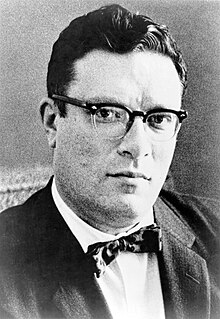
Isaac Asimov was an American writer and professor of biochemistry at Boston University. He was known for his works of science fiction and popular science. Asimov was a prolific writer, and wrote or edited more than 500 books. He also wrote an estimated 90,000 letters and postcards.
"Blind Alley" is a science fiction short story by American writer Isaac Asimov. It was first published in the March 1945 issue of Astounding Science Fiction, and later included in the collection The Early Asimov (1972).
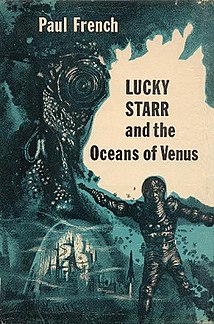
Lucky Starr and the Oceans of Venus is the third novel in the Lucky Starr series, six juvenile science fiction novels by Isaac Asimov that originally appeared under the pseudonym Paul French. The novel was first published by Doubleday & Company in 1954. Since 1972, reprints have included a foreword by Asimov explaining that advancing knowledge of conditions on Venus have rendered the novel's descriptions of that world inaccurate.

Fictional representations of the planet Venus have existed since the 19th century. Its impenetrable cloud cover gave science fiction writers free rein to speculate on conditions at its surface; all the more so when early observations showed that not only was it very similar in size to Earth, it possessed a substantial atmosphere. Closer to the Sun than Earth, the planet was frequently depicted as warmer, but still habitable by humans. The genre reached its peak between the 1930s and 1950s, at a time when science had revealed some aspects of Venus, but not yet the harsh reality of its surface conditions.
"Victory Unintentional" is a humorous science fiction short story by American writer Isaac Asimov, published in the August 1942 issue of Super Science Stories and included in the collections The Rest of the Robots (1964) and The Complete Robot (1982).
"Not Final!" is a science fiction short story by American writer Isaac Asimov, originally published in the October 1941 issue of Astounding Science Fiction, and included in the 1972 collection The Early Asimov. Its sequel, "Victory Unintentional", is a robot story. These are two of the few stories by Asimov to postulate non-human intelligences in the Solar system.
"The Callistan Menace" is a science fiction short story by American writer Isaac Asimov. It first appeared in the April 1940 issue of Astonishing Stories and was reprinted in the 1972 collection The Early Asimov. It was the second science fiction story written by Asimov, and the oldest story of his still in existence.
"History" is a science fiction short story by American writer Isaac Asimov. It was first published in the March 1941 issue of Super Science Stories and reprinted in the 1972 collection The Early Asimov.
"Homo Sol" is a science fiction short story by American writer Isaac Asimov. It was first published in the September 1940 issue of Astounding Science Fiction and reprinted in the 1972 collection The Early Asimov. It deals with the proposed acceptance into a galactic federation of hominid civilizations of the hominids of newly discovered Earth.
"The Hazing" is a science fiction short story by Isaac Asimov. It was first published in the October 1942 issue of Thrilling Wonder Stories and reprinted in the 1972 collection The Early Asimov. Discussing the story in The Early Asimov, the author noted that it is set in the same fictional universe as his earlier stories "Homo Sol" and "The Imaginary", but featured different characters. "The Hazing" was the thirtieth story written by Asimov, and the twenty-eighth to be published. Due to the peculiar workings of the science fiction magazine publishing industry, the story appeared a month before "The Imaginary".
"No Connection" is a science fiction short story by American writer Isaac Asimov. It was first published in the June 1948 issue of Astounding Science Fiction and reprinted in the 1972 collection The Early Asimov.
"Half-Breed" is a science fiction short story by American writer Isaac Asimov. It was first published in the February 1940 issue of Astonishing Stories and reprinted in the 1972 collection The Early Asimov. It was the fifteenth story written by Asimov, and the fourth to be published. At 9000 words, it was his longest published story to date.
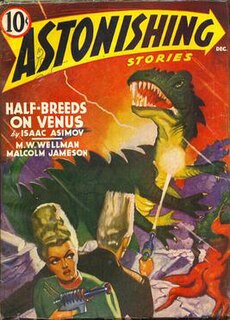
"Half-Breeds on Venus" is a science fiction short story by American writer Isaac Asimov. Asimov was asked by Frederik Pohl, editor of Astonishing Stories, to write a sequel to his earlier Tweenie story "Half-Breed", and he spent April and May 1940 doing so. He submitted the sequel to Pohl on June 3, and Pohl accepted it on the 14th, running it in the December 1940 issue of Astonishing. Asimov subsequently included the story in his 1972 collection The Early Asimov.
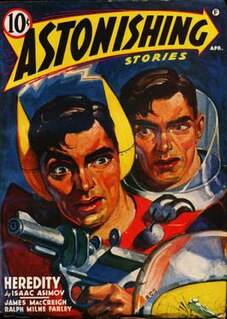
"Heredity" is a science fiction short story by the American writer Isaac Asimov. Asimov wrote the story, his twenty-third, in August 1940 under the title "Twins". It was rejected by John W. Campbell, editor of Astounding Science Fiction, on 29 August, and accepted by Frederik Pohl on 4 September. It appeared in the April 1941 issue of Astonishing Stories under the title "Heredity" and was reprinted in the 1972 collection The Early Asimov. Heredity was the second Asimov story to receive a cover illustration.
"Death Sentence" is a science fiction short story by American writer Isaac Asimov. It was first published in the November 1943 issue of Astounding Science Fiction and reprinted in the 1972 collection The Early Asimov.
"Christmas on Ganymede" is a science fiction short story by American writer Isaac Asimov. It was written in December 1940, first published in the January 1942 issue of Startling Stories, and reprinted in the 1972 collection The Early Asimov and the anthology Christmas on Ganymede and Other Stories, edited by Martin H. Greenberg. It was the twenty-sixth story written by Asimov, and the nineteenth to be published.
"Time Pussy" is an early science fiction short story by American writer Isaac Asimov.
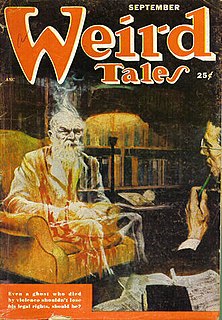
"Legal Rites" is a fantasy short story by American writers Isaac Asimov and Frederik Pohl, originally published in the September 1950 issue of Weird Tales, and included in the 1972 collection The Early Asimov.

"The Secret Sense" is a science fiction short story by American writer Isaac Asimov. It was written in 1939 and submitted to the magazine Astounding SF, but was rejected by its editor John W. Campbell, Jr.. It could not be placed by Asimov's agent, Frederik Pohl, and eventually it was taken for no payment by a new and short-lived magazine, Cosmic Stories in March 1941, although Asimov did ask for a token payment of $5 from the editor, Donald A. Wollheim, or else for the story to be published under a pseudonym, before the story was published. This was requested on the grounds that "even though the story might be worth nothing, my name was worth something". Wollheim reluctantly agreed to a payment of $5, commenting that it was an effective word rate of $2.50 per word, since he was paying only for the use of Asimov's name. Asimov described the letter from Wollheim with the $5 payment as "needlessly nasty". He later commented to Damon Knight that he might have just given Wollheim the $5 back in cash after receiving the check, but that the option never occurred to him at the time. The story was reprinted in the collection The Early Asimov in 1972.
Isaac Asimov wrote three volumes of autobiography. In Memory Yet Green (1979) and In Joy Still Felt (1980) were a two-volume work, covering his life up to 1978. The third volume, I. Asimov: A Memoir (1994), published after his death, was not a sequel but a new work which covered his whole life. This third book won a Hugo Award.







